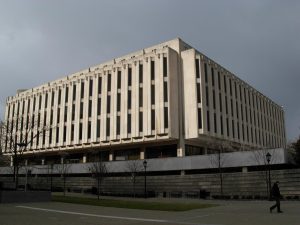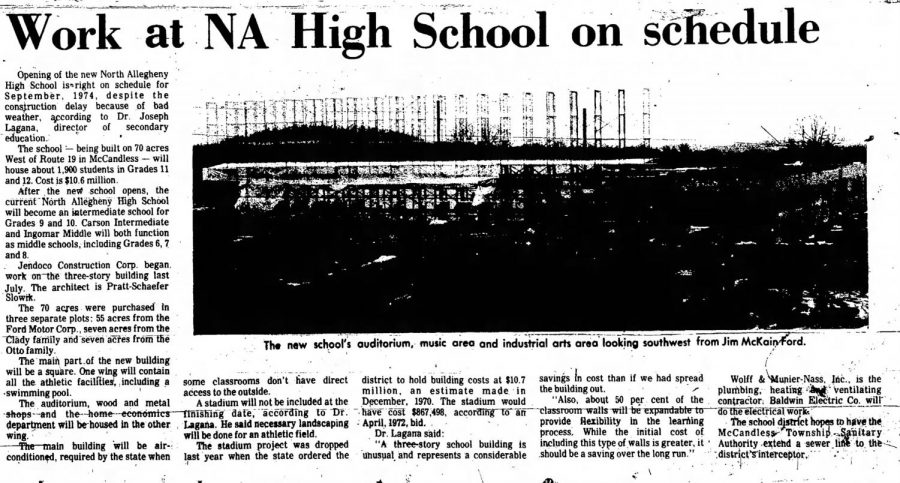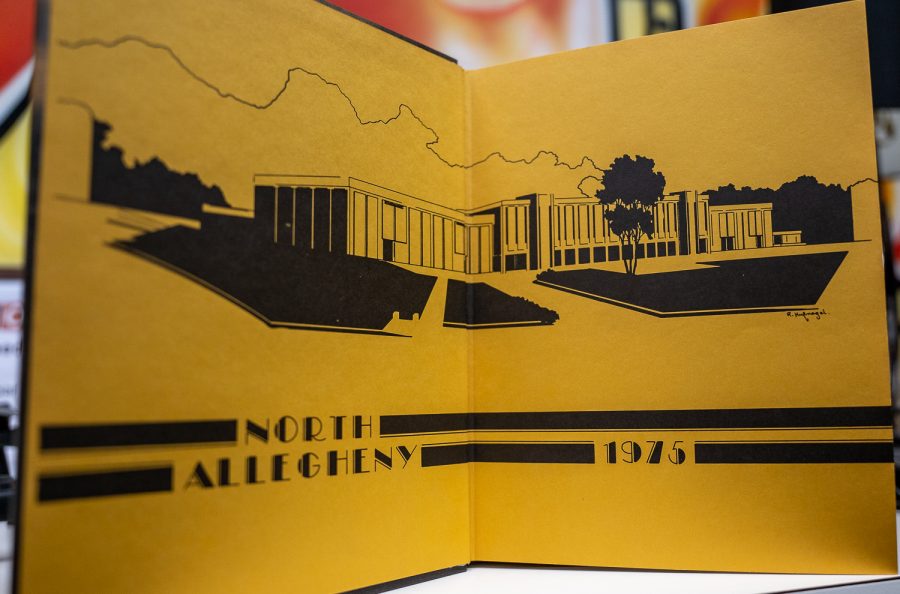It’s Not Ugly… It’s Brutalist
The construction of North Allegheny Senior High School in 1974 marked a unique and important milestone in the district’s expansion.
The inside cover of the 1974-1975 NASH yearbook included this artistic interpretation of the school.
Given its notable lack of windows and sharp exterior, practically every NASH student has heard the rumor that the school was designed by a prison architect. Considering the building’s fortress-like appearance, is it too far-fetched to think that its designer meant to make a dark statement about the nature of public education?
As it turns out, the reality is not that dramatic.

The architect of NASH was a local firm known as Pratt-Schafer-Slowik. A search through old newspapers turns up their work designing several other area schools — including North Hills High School and Hosack Elementary — but no prisons. The design of NASH is simply a reflection of the time at which it was built.
NASH is an example of Brutalist architecture, a popular style in institutional buildings in the 1970s. Brutalism, which got its name from a French word for concrete, has a fitting name, placing emphasis on bare building materials over decoration, appropriate in practical buildings such as schools. The Brutalist movement held that a building’s purpose should dictate its design. Though popular for a time, some critics find Brutalist structures outdated and unsightly.
When NASH opened in September 1974, students were surprised at the school’s bold design. After all, they were coming from NAI, a more airy and open building than NASH. For just five years after the construction of Carson Intermediate High School in 1969, present-day NAI was known as North Allegheny Senior High School and housed grades 11 and 12.
“It’s really different from the old NA — no ramps, no windows, no courtyards (I really liked them) no crowded lunchroom (a real shame – huh!),” remarked one person in the 1974-1975 yearbook, which included anonymous student reflections on its inside covers.
Interpretations of the building’s design were apparently wide-ranging, as the student added that “one friend thought that it looked like a hospital, another thought that it resembled the ‘Starship Enterprise.’”

Plans were underway for NASH as early as 1969. The North Hills News Record reported on February 19 of that year that land had been “purchased from the Ford Motor Co. which is also building on the highway frontage. The school site is on the rear of what was the Gannon Farm.”
The 1973 school year was the original target date, but it would not be until late 1974 that NASH opened to students.

During the planning stages of NASH, the North Hills News Record interviewed Joseph Lagana, Director of Secondary Education at the time, on the building’s unorthodox design.
“A three-story school building is unusual and represents a considerable saving in cost than if we had spread the building out,” Laguna said in the paper’s January 10, 1973 edition.
In the months leading up to the building’s opening, the News Record ran a story about NASH on May 8, 1974, titled “All signs are GO for Sept. 4.” Though this target date was met, aspects of the school remained uncompleted throughout the 1974-1975 school year.
With work continuing on the unfinished gym, auditorium, and television studio, one student in the 1975 yearbook recalled early “gym classes in the cafeteria” covering a wide variety of subjects. Lessons included “badminton, ping pong, wrestling, massage, and social dancing.”
Another late edition was Newman Stadium, which was not built with the rest of the school because residents raised concerns over tax increases. In an article from The Pittsburgh Press on October 1, Superintendent Carl A. Newman acknowledged “major controversy… over a proposed 5,000 seat stadium next to the school,” which led its construction to be pushed back to the following school year. (Interestingly, the stadium would be named for Newman himself.)
Today’s students may find it humorous that, at the time of its construction, some considered NASH to have “unnecessary frills” and to be “too lavish,” as stated by the Press. Though “lavish” may not be the best word to describe any school, it is clear that NASH had many admired amenities when it was built.
In the early days of NASH, teachers’ desks were in offices separate from their classrooms to allow for flexibility in moving classes. A feature that is equally unusual today was a smoking lounge. From one account, it seems as if all students — even those who didn’t smoke — were glad to have one.
“It was getting to be pretty blue in the lavs and non-smokers even thought it would be a good idea to give the smokers a lounge,” said a student in the 1975 yearbook. This was truly the NASH of a different time.

In 1974, Superintendent Newman said that NASH “[won’t] be paid off until 2008. Who knows what kind of school we might want by then?”
He could likely never imagine a school where every student had their own computer and teachers could erase their board with the touch of a button. In the 21st century, the most important advancements in education have not relied on the physical school building itself; they have been dependent on the microchip.
However, some school experiences remain the same from generation to generation. In NASH’s inaugural yearbook from nearly half a century ago, one student made this joking comparison: “The first couple of weeks in the new school were a three-ring circus.”
Even as NASH begins its 48th school year, some things never change.

Years after editing and delivering the Carson Middle newspaper by himself, Andrew McLaughlin is excited to be Co-Editor-in-Chief of The Uproar. Always a fan of amusement park history, he has written for the magazine of the National Amusement Park Historical Association. He also volunteers at the Depreciation Lands Museum, a local living history museum. Andrew welcomes comments about his writing.


Ben Quint • Oct 1, 2021 at 9:22 am
Nice work, Andrew! I was just talking about NASH’s design to a friend this week. It’s certainly a little imposing. I’d have to imagine that the bare look saved a lot of money. Now you’ve got me curious about Superintendent Newman, too!
Cris Ruffolo • Sep 28, 2021 at 12:08 pm
This is a great article. Keep it for your portfolio (and maybe we can make it available for students in the years to come…it explains so much, so well! )
Congratulations!
Joy Manesiotis • Sep 24, 2021 at 12:55 pm
Fantastic article! Full of research, history and humor!!!
Joe McLaughlin • Sep 23, 2021 at 8:43 pm
Great article, Andrew! I always learn something new from your writing.
Zack Hull • Sep 23, 2021 at 2:06 pm
Amazing work as usual, Andrew.